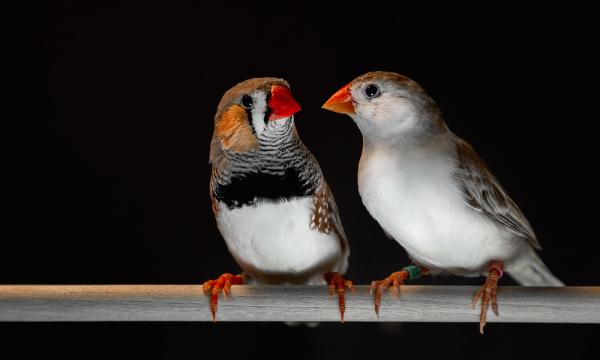For many people, the twitter of songbirds is a welcome sign that spring has arrived. But for Jon Sakata, a neurobiologist at McGill University, the melodic calls and answers from among the tree branches reveal something even more alluring: clues about how humans produce speech and acquire language.
“Songbirds are special in that, like humans, they have to learn their vocalizations during development,” he explains. Given that most animals — and even the majority of birds — communicate through innate vocalizations (that is, they never have to learn them), the learning process of songbirds makes them a unique animal model for what happens in the human brain when we’re learning to speak or picking up a new language. And those insights could have important implications for conditions like autism and Tourette syndrome.
Humans and finches: two birds of a feather
One aspect of Sakata’s research aims to understand the differences between a bird that learns to sing by interacting with an adult tutor compared to one that learns to sing passively through recordings. To do this work, his team uses CFI-funded sound attenuating chambers and microphones to create high-fidelity recordings of the birds singing.
What they’ve found is good advice for any human language learner: juveniles pay more attention when the tutor is present, and the more they pay attention, the better they learn.
“They can learn if you play sounds through a speaker, but they don’t learn to imitate the sounds as well, and it takes them longer,” says Sakata. When an adult bird is present, the juvenile will stop what they’re doing and observe the adult closely. “They learn that song a lot faster, a lot better. It’s just a more robust paradigm for vocal learning.”
Sakata suspects there may be reasons other than purely the value of paying attention for why social interaction helps young birds learn, including visual cues like beak and body movements and the tutor’s breathing patterns while it sings.
It’s the same with human babies. “When a baby is looking at and interacting with their parents, there’s a lot of social interactions going on,” says Sakata. “Babies pay a lot of attention to the mouth and to the eyes of their caregivers. And when they pay attention to the mouth, it helps them encode how to produce those sounds.”
In the first four clips of this recording, listen as a young zebra finch masters his song, beginning with a noisy jumble at 35 days old, then improving at 50, 70 and finally 90 days old, when he’s considered an adult. Compare his 90-day song to that of his tutor in the fifth clip to hear how practice makes perfect.
Bird brain: a window into our own neurobiology
Besides establishing the correlation between attention, social interaction and learning, Sakata’s research team is also looking at the neurobiological processes underlying those relationships. They have been able to pinpoint areas in the bird brain that are engaged when a bird is learning to sing, including those responsible for producing neurochemicals for reward and motivation, such as dopamine, as well as those for attention and arousal, such as norepinephrine. Both areas are more active and concentrations of the key brain chemicals are higher when birds are learning “in-person” rather than through recordings.
The researchers have taken it a step further and found that by tricking the bird’s brain into thinking it is being socially tutored by artificially increasing the concentrations of norepinephrine in key parts of its brain, they can get the bird to learn better and reproduce more accurate imitations of the tutor’s song.
Sakata acknowledges that translating these findings into improving how humans acquire speech and learn new languages is a long road, but one worth following.
For one thing, these studies could provide insight into what may go awry in developmental disorders like autism. Some studies suggest that dysfunctions in neurochemistry lead to deficits in social behaviour and vocal learning in people with autism. “If we could somehow ameliorate some of these neurochemical differences between autistic individuals and non-autistic individuals, you could help autistic people improve their communication skills,” Sakata hypothesizes.
The researchers are also trying to understand other patterns of birdsong, such as how a male will modify the quality of its song when it is tutoring a young bird or when it sings to a female, versus when he’s just singing for himself. Understanding the neural processes behind changing vocalizations for different social contexts in birds could provide insight into human conditions like Tourette syndrome, which is partly characterized by inappropriate utterances in social situations.
Sakata hopes his work with songbirds will provide the foundational knowledge required to explore those possibilities.
In the first clip, hear how an adult male alters his song when he's teaching a juvenile versus the second clip when he’s singing to himself (the zebra finch’s equivalent to singing in the shower). When he is in tutor mode, he pauses between his phrases, possibly to make each one distinct for the young bird to learn.
Using citizen science to assemble a global bird chorus
To gain a broader view of what birdsong can teach us, Sakata’s team is engaged in a global citizen science project in which bird enthusiasts around the world can upload recordings of the species they hear. Using those recordings, Sakata’s team is identifying common acoustic phenomena in the songs of about 300 species of birds, as well as several ways in which those patterns overlap with human speech and music.
One example is a preference for small pitch intervals. Except for a few virtuosos, when people sing, they don’t often go from a very low to a very high pitch. Instead, like birds, they tend to transition between notes of a similar acoustic frequency.
There is also the phenomenon of alternating syllables in speech. “You don't often have a strong, strong, weak, weak pattern,” says Sakata. “Most often, you have an alternation between strong and weak, strong and weak. And you see that alternation in many different languages around the world.” Birds do the same.
Another common occurrence is called a phrase final elongation in which the final sound in a phrase tends to be drawn out, both in human speech and birdsong.
Birds prefer to produce these motifs so much that when tutored with random sequences of notes of different frequency and emphasis, they will rearrange them in a manner that “reproduces these speech and music universals,” says Sakata. “They produce a phrase where the last syllable is the longest and where there is stress alternation between low and high pitch sounds.”
Sakata takes a pragmatic view of this human connection to the avian world. “It makes sense because it's pretty hard to accurately go from a really low pitch to a high pitch, especially when you are singing fast,” he says. “There might be some motor constraints that shape the sequence of sounds that birds produce in the same way that these motor biases shape the sequence of sounds that people produce in music.” For example, a phrase final elongation might be “purely respiratory,” the sound drawing out as our lungs and diaphragm relax.
Sakata remains nevertheless compelled by this kinship with winged creatures and how we communicate. “I find it fascinating that you find these same patterns in humans and birds, and that humans are not necessarily unique in this capacity.”







